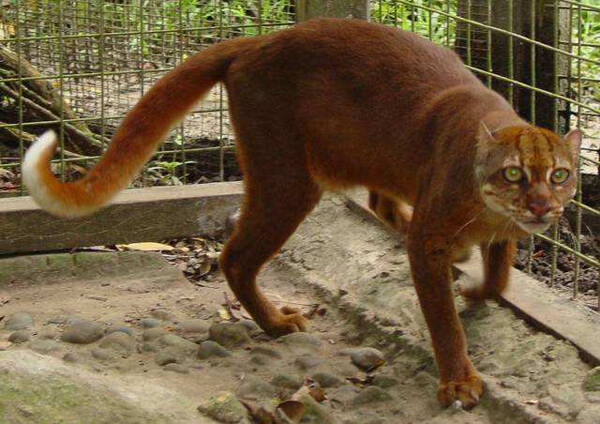Catopuma badia
IUCN
LCBasic Information
Scientific classification
- name:Catopuma badia
- Scientific Name:Catopuma badia,Borneo Bay Cat,Chestnut cat
- Outline:Carnivora
- Family:Felidae Felis
Vital signs
- length:45-67cm
- Weight:3-4kg
- lifetime:About 12 years
Feature
Smaller than the Asian golden cat, its fur is usually reddish brown, but there are also a few gray variants.
Distribution and Habitat
The Bornean golden cat is found in Indonesia (Kalimantan) and Malaysia (Sabah, Sarawak).
The Bornean golden cat's main habitat is located in the rocky hilly areas of the island, close to the dense tropical jungle. It lives in densely forested areas, close to the edges of rivers and other waterways.
Appearance
The Borneo Golden Cat is about the same size as a domestic cat, with males having a head-body length of 45.5-67 cm and a tail length of 32.5 - 38.5 cm; females have a head-body length of 45.2-62 cm and a tail length of 32-40.3 cm. It weighs 3-4 kg. Its back and sides are relatively evenly colored, usually with lighter fur on the underparts, a golden belly, and a white chin. Two faint brown stripes can be seen on the cheeks, and the back, belly, and limbs may also be covered with black spots. The hair on the nape of the Borneo Golden Cat, the crown, and the hair on the cheeks and front of the throat grow forward rather than backward. There are two types of fur colors. Most Borneo Golden Cats have chestnut red fur with faint black markings on it, and the fur on the belly and inside of the limbs is a lighter yellow-brown color with some small black spots on the fur. There is also a gray color, which is less common.
The Bornean Golden Cat has very distinctive facial markings, with a dar
Details
Borneo Golden Cat (scientific name: Catopuma badia) is also known as Borneo Bay Cat in foreign languages. It has no subspecies.

In 2006, Johnson and Eizirik et al. studied the Bornean golden cat together with the Asian golden cat and clouded cat of the same genus, and determined that the Bornean golden cat was not a subspecies of the Asian golden cat. They believed that it was very different from its existing relatives about four million years ago, and had evolved into an independent species long before Borneo separated from the mainland.
The Borneo golden cat has the same living habits as the Asian golden cat. Except for the breeding season, it usually lives alone and is nocturnal. It is more active at dawn and dusk. It lives in tree caves during the day and occasionally moves on the ground. It is agile and good at climbing, but mostly moves on the ground. The activity area is relatively fixed, and it migrates vertically with the change of seasons. The food is mainly rodents, but also includes birds, young rabbits and chickens, as well as small deer such as muntjacs and musk deer.
The breeding habits of the Borneo golden cat are roughly the same as those of the Asian golden cat. It can breed all year round. The female golden cat's estrus lasts for 6 days, which repeats every 39 days. The gestation lasts 81 days. Females give birth to 1-3 pups per litter, with an average birth weight of 250 grams. The cubs are weaned at 6 months and are independent at an average of 12 months, although they can become independent in as little as 9 months. Females reach sexual maturity at 19-174 months and males at 24-156 months.
The greatest threat to the survival of the Bornean golden cat is habitat loss due to commercial logging and conversion of forests to oil palm plantations. Oil palm plantations are likely to expand in the future, driven by demand for biofuels, and if deforestation rates continue, forest cover on the island of Borneo is expected to drop from 50% to less than a third by 2020. Poaching, especially using snares, poses a significant threat to the species. Wildlife traders know the species is rare, and illegal capture of the Bornean golden cat for its fur and pet market continues.
Conservation Action: Includes listing in Appendix II of the Washington Convention on International Trade in Endangered Species (CITES). The Bornean golden cat is adequately protected by national legislation throughout most of its range. Hunting and trade are prohibited in Indonesia (Kalimantan) and Malaysia (Sabah and Sarawak). The following protected areas have been confirmed: Sabah: Damu Valley Conservation Area; Sarawak - Gunung Mulu National Park, Lanjak-Entimau Wildlife Sanctuary; Kalimantan: Gunung Bayon National Park, Bentun Tangkarim National Park, Sungai Winn Shelterbelt Forest).
Listed on the 2016 IUCN Red List of Threatened Species, ver 3.1 - Endangered (EN).
Listed in the CITES Appendix II protected animals of the Washington Convention.
Protect wild animals and eliminate game.
Maintaining ecological balance is everyone's responsibility!








